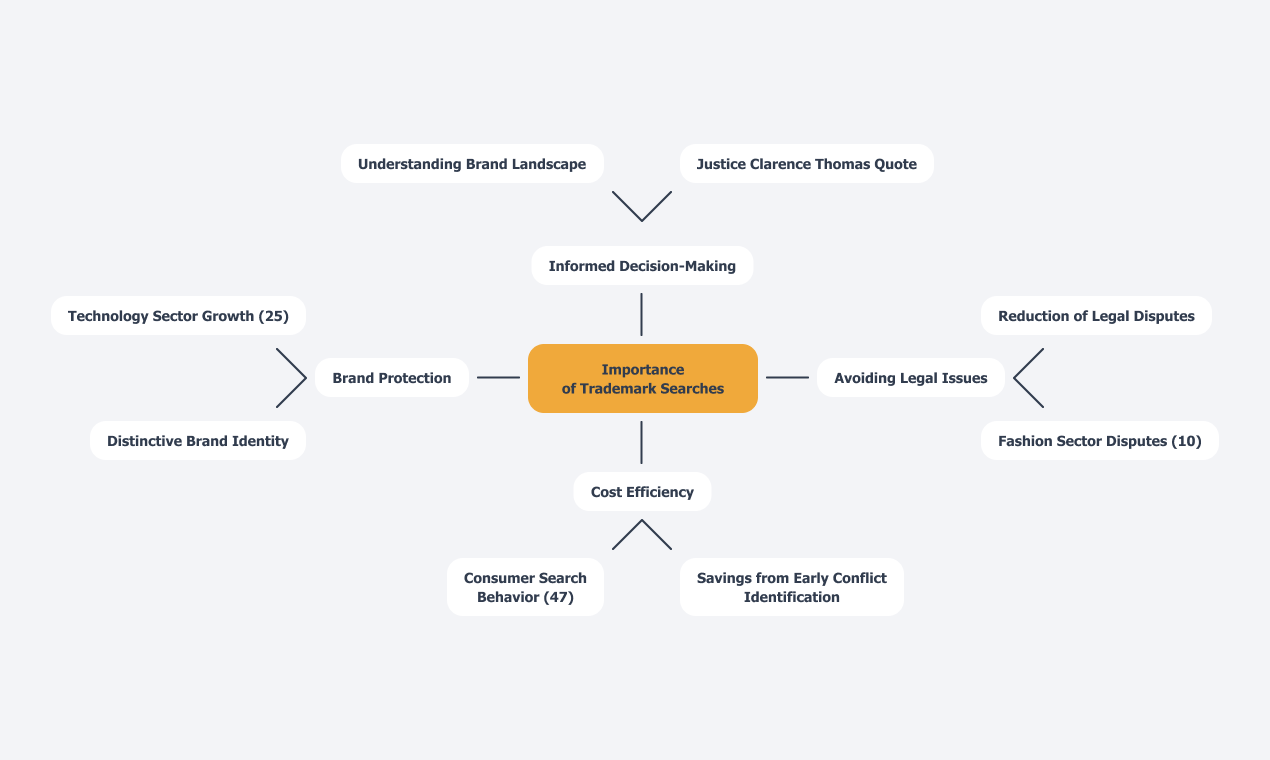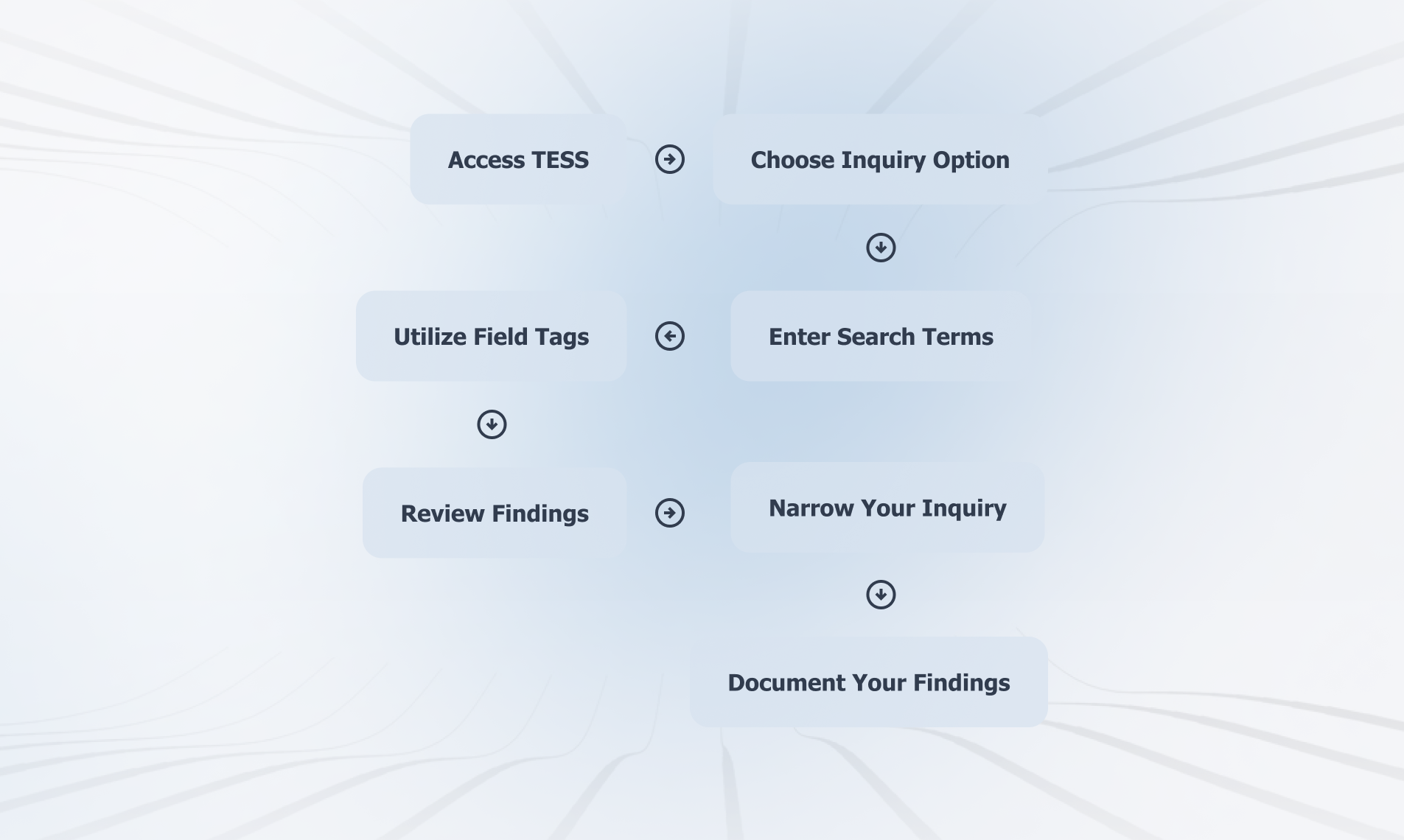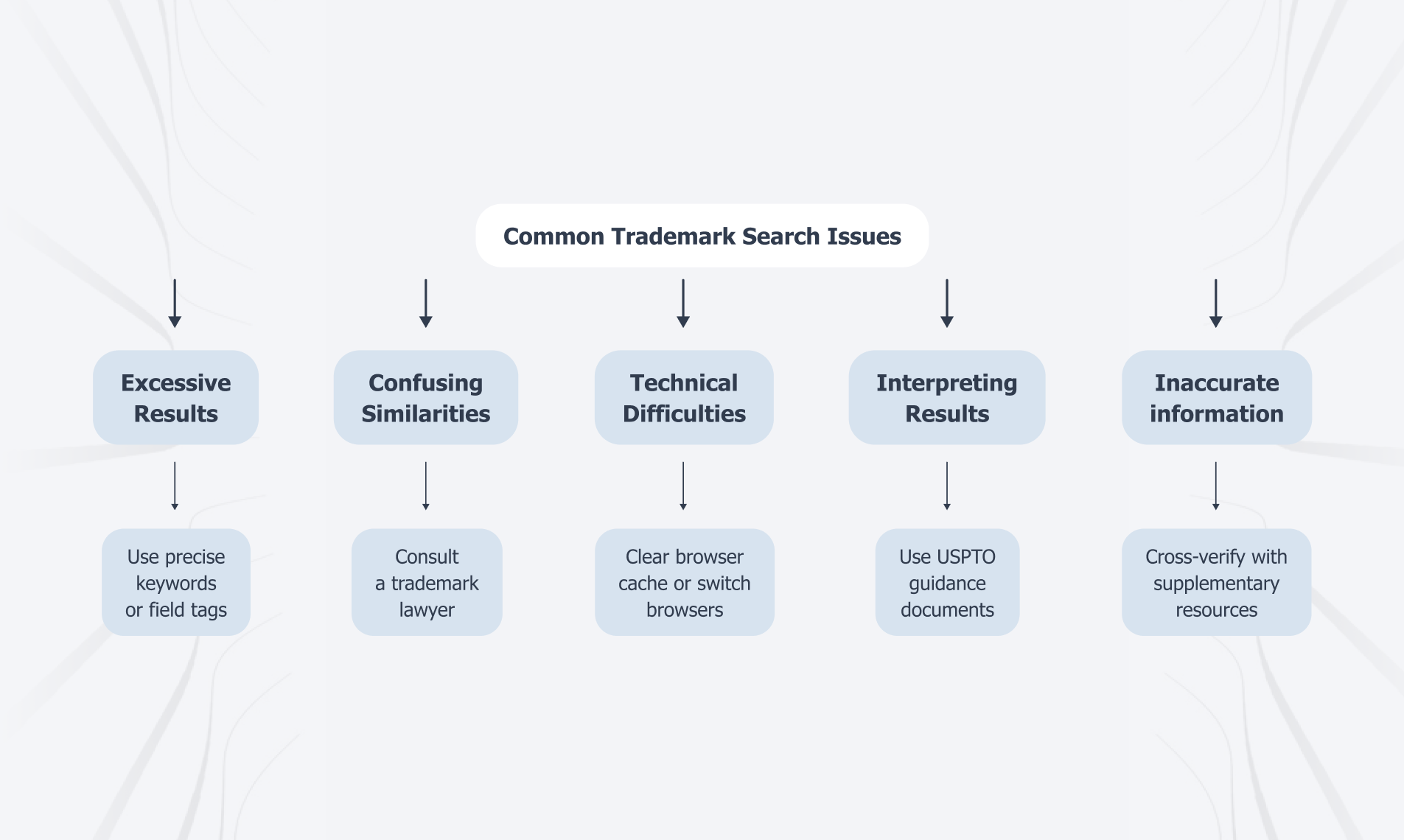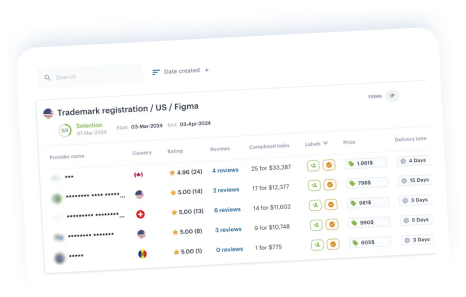Overview
This article serves as a comprehensive step-by-step guide for conducting a trademark search using the USPTO’s TESS system. It underscores the critical importance of thorough investigations to avert legal complications, reduce costs, and safeguard brand identity. Supported by compelling statistics that reveal the prevalence of intellectual property disputes, the article illustrates the advantages of informed decision-making. It is evident that effective trademark searches are essential for businesses navigating the intricate landscape of brand registration and protection.
Introduction
In the competitive landscape of business, safeguarding intellectual property is paramount; trademark searches are integral to this endeavor. As organizations strive to establish their brand identities, recognizing the significance of thorough trademark searches not only prevents costly legal disputes but also enhances brand protection and informs strategic decision-making.
With the surge in trademark applications, particularly in sectors such as technology and fashion, the necessity for a comprehensive approach to trademark searches has never been more critical. This article explores the importance of conducting trademark searches, offers a step-by-step guide for utilizing the USPTO’s resources, and addresses common challenges encountered during the search process.
By equipping businesses with the knowledge to navigate these complexities, it underscores the essential steps toward securing a unique and legally sound brand presence.
Understand the Importance of Trademark Searches
Trademark investigations are essential for several compelling reasons, one of which is the trademark uspto search:
- Avoiding Legal Issues: Conducting a brand search is crucial for identifying existing marks that may conflict with your proposed label, significantly reducing the risk of legal disputes. In 2023, intellectual property disputes in the fashion sector alone represented 10% of all cases filed, underscoring the significance of proactive measures.
- Cost Efficiency: Early identification of potential conflicts can save businesses from costly litigation and rebranding efforts later on. Statistics reveal that 47% of buyers who acquired a product breaching a brand’s rights later searched for the product’s name online, emphasizing the financial consequences of such violations.
- Brand Protection: A thorough investigation guarantees that your brand identity is distinctive, which is essential for creating a robust market presence. The technology industry has experienced a 25% rise in brand registrations over the past five years, indicating the increasing acknowledgment of brands as vital instruments for protecting intellectual property. This rise highlights the importance of conducting a trademark uspto search to safeguard your identity in a competitive environment.
- Informed Decision-Making: Understanding the landscape of current brand identifiers enables businesses to make informed choices regarding their branding strategies. This knowledge is particularly important in a rapidly evolving market where innovation drives competition. As Justice Clarence Thomas pointed out, the intricacies of branding law require thoughtful evaluation and planning in branding initiatives, and conducting a trademark uspto search is a crucial phase in the registration process that can conserve time, resources, and effort over time, while also strengthening a company’s stance in the market. For corporate IP managers, these insights are indispensable for navigating the complexities of brand law and making informed decisions that safeguard their organizations’ intellectual property.

Follow Step-by-Step Instructions for Conducting a USPTO Trademark Search
To conduct a trademark search on the USPTO website, follow these steps:
- Access the USPTO Trademark Electronic Retrieval System (TESS): Begin your journey by navigating to the USPTO TESS portal.
- Choose Your Inquiry Option: Decide between the ‘Basic Word Mark Inquiry’ for straightforward queries or the ‘Advanced Inquiry’ for more complex investigations.
- Enter Your Search Terms: Input the name or phrase you wish to look up. Remember to use quotation marks for exact phrases (e.g., “Your Trademark”).
- Utilize Field Tags: For improved inquiries, employ field tags such as ‘CM’ for combined marks or ‘GS’ for goods and services. For instance, enter
CM:YourTrademark. - Review Findings: Carefully analyze the results, focusing on trademarks that are similar or identical to your proposed mark.
- Narrow Your Inquiry: If the results are too broad, refine your query by adding keywords or utilizing the available filters.
- Document Your Findings: Record your search results for future reference, particularly if you plan to consult with a legal professional.
In 2025, the USPTO’s TESS system remains an essential tool for businesses, evidenced by a significant rise in brand applications related to blockchain technology, which increased by 15% in the prior year, leading companies to perform a trademark USPTO search. Furthermore, the USPTO provides access to the Trial and Appeal Board Reading Room, a critical resource for understanding brand disputes and rulings.
Effective brand searches can greatly improve the chances of registration. This is illustrated by strategies employed by attorneys to navigate the complexities of the application process. For example, the case study titled “Strategies to Mitigate Trademark Application Rejection” outlines effective approaches that applicants can adopt to enhance their success rates. Moreover, as noted in the case ‘In re Hulting,’ ‘The more frequently a [term or expression] is employed, the less probable it is that the public will associate it with a single source and the less likely it will be acknowledged by buyers as a brand [or service mark].’ By adhering to these steps, you can effectively assess the availability of your desired mark and make informed decisions regarding your intellectual property.

Troubleshoot Common Issues in Trademark Searches
Carrying out a brand investigation presents several challenges that can hinder the effectiveness of your efforts. Understanding these common issues and employing strategic solutions can significantly enhance your inquiry.
- Excessive Results: An inquiry yielding an overwhelming number of outcomes can complicate your research. To refine your trademark uspto search, consider using more precise keywords or field tags that focus on specific aspects of the brand. For instance, companies within the fashion industry have successfully narrowed their search results by including specific product categories or brand names, which is particularly vital given that brand disputes in this sector accounted for 10% of all cases filed in 2023.
- Confusing Similarities: Encountering brands that bear resemblance yet are not identical can introduce uncertainty. Evaluate the likelihood of confusion by examining the characteristics of the products or services associated with each mark. Consulting a trademark lawyer can provide valuable insights in these situations, especially since 47% of consumers who purchased a product that infringed a trademark had entered the product’s name into a trademark USPTO search, underscoring the necessity of clarity in trademark inquiries.
- Technical Difficulties: Should you face challenges accessing the USPTO website or navigating the Electronic Search System (TESS), consider performing a trademark uspto search by clearing your browser cache or switching to an alternative browser. A reliable internet connection is also essential for a seamless experience. Furthermore, leveraging iPNOTE’s innovative tools can automate task creation and streamline your workflow. For example, iPNOTE’s automation features enable you to set reminders for critical deadlines and organize tasks efficiently, simplifying the management of these technical aspects.
- Interpreting Results: Comprehending search results can be intricate. Utilize the USPTO’s guidance documents for clarification on your trademark uspto search, or connect with the Trademark Assistance Center for tailored support. Additionally, iPNOTE’s collaboration tools enhance communication within your team, ensuring that all members are aligned on interpreting results and determining next steps. Be mindful of the potential repercussions of failing to renew registrations, as this can jeopardize your rights and lead to disputes.
- Inaccurate Information: If you suspect that the database contains outdated or erroneous information, cross-verify with supplementary resources or consult a legal expert to ensure accuracy. iPNOTE’s services can assist you in maintaining a well-organized repository of your intellectual property, thereby minimizing the risk of relying on incorrect information.
By recognizing these prevalent challenges and implementing effective problem-solving techniques, along with the support of iPNOTE’s automation and collaboration tools, you can significantly enhance your brand name investigation experience. By refining your approach, you can mitigate risks and navigate the complexities of brand registration more adeptly. Remember, thorough searches are crucial not only for protecting your brand but also for avoiding the pitfalls associated with trademark disputes.

Conclusion
Conducting thorough trademark searches is essential for establishing and safeguarding a brand’s identity in today’s competitive market.
Recognizing the importance of these searches enables businesses to effectively avoid legal disputes, save costs, and ensure their brand remains unique. The statistics highlighting the prevalence of trademark conflicts, particularly in industries such as fashion and technology, underscore the necessity for proactive measures to protect intellectual property.
Utilizing the USPTO’s Trademark Electronic Search System (TESS) offers a structured approach to navigating potential trademark conflicts. By following a systematic process, businesses can refine their searches, document findings, and make informed decisions regarding their branding strategies. Furthermore, understanding common challenges, such as excessive results or confusing similarities, equips organizations with the tools needed to troubleshoot effectively and interpret search outcomes accurately.
Ultimately, the complexities of trademark law highlight the necessity for diligent trademark searches as a foundational step in building a legally sound and distinctive brand presence. By prioritizing comprehensive searches and leveraging available resources, businesses not only protect their intellectual property but also enhance their strategic decision-making, thereby securing their position in a rapidly evolving marketplace.
Secure Your Brand’s Future with Smart Trademark Searches. Start now with iPNOTE and protect your intellectual property effortlessly.
Frequently Asked Questions
Why are trademark investigations important?
Trademark investigations are essential for avoiding legal issues, ensuring cost efficiency, protecting brand identity, and facilitating informed
decision-making regarding branding strategies.
How can conducting a brand search help avoid legal issues?
A brand search helps identify existing trademarks that may conflict with your proposed label, significantly reducing the risk of legal disputes, which is particularly relevant given that intellectual property disputes in the fashion sector represented 10% of all cases filed in 2023.
What are the financial benefits of early trademark conflict identification?
Early identification of potential trademark conflicts can save businesses from costly litigation and rebranding efforts, as 47% of buyers who purchased a product infringing on a brand’s rights later searched for the product’s name online, highlighting the financial consequences of such violations.
How does a trademark investigation contribute to brand protection?
A thorough trademark investigation ensures that your brand identity is distinctive, which is crucial for establishing a strong market presence.
The technology industry has seen a 25% increase in brand registrations over the past five years, indicating the growing importance of brands in protecting intellectual property.
What role does understanding the current brand landscape play in decision-making?
Understanding the current brand landscape allows businesses to make informed choices about their branding strategies, which is vital in a rapidly evolving market driven by innovation. This knowledge helps conserve time, resources, and effort while strengthening a company’s market position.
Why is a trademark USPTO search considered a crucial phase in the registration process?
Conducting a trademark USPTO search is vital in the registration process as it helps in evaluating branding initiatives thoughtfully, ultimately aiding corporate IP managers in navigating the complexities of brand law and safeguarding their organizations’ intellectual property.






